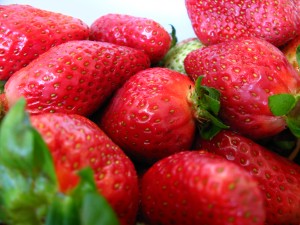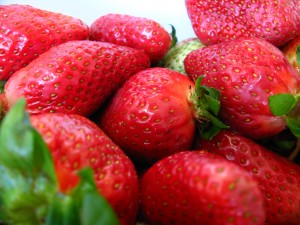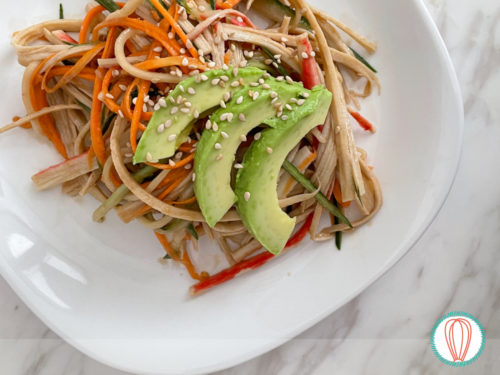
Featured Fruit of the Month: Strawberries
This post is also available in / Esta entrada también está disponible en ESPAÑOL (SPANISH)
As our new feature at The Foodies’ Kitchen, we will be presenting a monthly fruit or vegetable every month. We know them, we have tasted them, we buy them at the grocery store or the market all the time, but we don’t usually know about their health benefits, and it doesn’t hurt to know about new ways to incorporate them into our every day meals.
It is recommended that we eat 2-4 servings of fruits and 2-4 servings of vegetables a day, be it raw, frozen, cooked, or juiced. I don’t know about you, but I am not filling that quota.
So how much is one serving anyway? I looked it up.
One serving equals 1 cup of fruit or vegetable or 100 percent fruit or vegetable juice, or 1/2 cup of dried fruit. Because fruits come in so many different shapes and sizes, it’s hard to say how many pieces of fruit count as a serving.
- Generally, 1 serving size of whole fruit = 1 tennis ball
- 1 serving size of cut fruit = 7 cotton balls
The Foodies’ Kitchen Recipes
Strawberry Cake
Kiwi, Strawberry and Spinach Salad
Rhubarb & Strawberry Crumble Pie
Cooking with Kids: Strawberry Parfait Pops
Strawberry Bread
Health Benefits:
Strawberries as we know them today are a hybrid of different species, specifically selected by breeders during the centuries to yield more crop, with a better taste and a more nutritious profile.
In addition to having a very important nutritional value, with an abundance of antioxidants like anthocyanins, strawberries have been used for centuries as symbols of purity and longevity (they were used as sacred symbols by Christian stonemasons) and depending on cultures were believed to prolong life (like the famous 18th century writer Fontenelle, a centenarian who believed strawberries to be the cause of his longevity).
Like many other berries, strawberries contain high amounts of antioxidants, in particular anthocyanins type 2 and ellagitannins. These pigments are responsible for strawberries’ red color, as well as their powerful oxygen quenching capabilities.
Antioxidants like anthocyanins have been shown by several studies to be effective in reducing risks of developing cancer, cardiovascular disease and inflammation-related diseases. They can be considered a safer version of aspirin in their anti-inflammatory properties and are also an excellent source of Vitamin C.
How to Select and Store:
As strawberries are very perishable, they should only be purchased a few days prior to use. Choose berries that are firm, plump, free of mold, and which have a shiny, deep red color and attached green caps. Since strawberries, once picked, do not ripen further, avoid those that are dull in color or have green or yellow patches since they are likely to be sour and of inferior quality. Full ripe berries will not only have the peak flavor and texture, but will have more nutrients. “Full ripe” in this case means optimally ripe, not overripe. Both underripe and overripe strawberries have been show to have lower vitamin C content and decreased phytonutrient content in comparison to optimally ripe strawberries.
Medium-sized strawberries are often more flavorful than those that are excessively large. If you are buying strawberries prepackaged in a container, make sure that they are not packed too tightly (which may cause them to become crushed and damaged) and that the container has no signs of stains or moisture, indication of possible spoilage. Strawberries are usually available year round, although in greatest abundance from the spring through the mid-summer.
The very fragile nature of strawberries means that great care should be taken in their handling and storage. Before storing in the refrigerator, remove any strawberries that are molded or damaged so that they will not contaminate others. Place the unwashed and unhulled berries in a sealed container to prevent unnecessary loss of humidity. Strawberries will maintain excellent nutrient content if properly stored in a refrigerator for two days. The optimal temperature for storage is 2-3º C
A Few Quick Serving Ideas:
- Add sliced strawberries to mixed green salad.
- Layer sliced strawberries, whole blueberries and plain yogurt in a wine glass to make a parfait dessert.
- Blend strawberries with a little bit of orange juice and use as a refreshing coulis sauce.
- Add strawberries to breakfast shakes to give them a more vibrant taste and texture.
Facts and Trivia:
- Strawberries are the first fruit to ripen in spring
- The strawberry plant belongs to the same family of roses, genus Fragraria, together with other fruits such as apples and plums. The name of the genus comes from the Old Latin word for “fragrant”. In modern Italian, the word for strawberry is still “fragola”
- In Belgium there’s a museum entirely dedicated to strawberries
- Strawberries were a symbol of perfection and love: for instance, folklore says that if you split a double strawberry in half and share it with a member of the opposite sex, you’ll soon fall in love. Medieval stonemasons carved strawberry designs on altars and around the tops of pillars in sacred places such as churches, as a symbol of perfection
- Strawberries are the only fruit with seeds on the outside. It is argued that for this reason, it cannot be considered a real berry, since berries carry seeds on the inside
- A strawberry has, on average, 200 seeds
- If all the strawberries produced in California, in one year, were laid berry to berry, they’d wrap around the world 15 times
© 2011 – 2020, The Foodies’ Kitchen. All rights reserved | Todos los derechos reservados
This post is also available in / Esta entrada también está disponible en ESPAÑOL (SPANISH)




